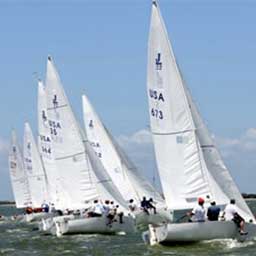Offshore Passage Making graduates will have successfully demonstrated the ability to responsibly skipper and crew an inboard auxiliary powered cruising sailboat to any destination worldwide.
Recommended Equipment: It is recommended that Offshore Passage Making courses be conducted on 35’ or larger cruising keelboats with wheel steering and auxiliary diesel power, and with adequate equipment inventory to complete all required certification outcomes.
Prerequisites: The prerequisites for Offshore Passage Making Certification is a US Sailing Coastal Passage Making Certification. Celestial Navigation is recommended, but not required. In addition, valid CPR and First Aid certifications as recognized by the U.S. Coast Guard is required before OPM certification can be issued.
Certification Requirements: Offshore Passage Making Certification requires the successful completion of the following knowledge and skill requirements. These requirements are expected to be performed safely with confident command of the boat in waters of the open ocean with a wind speed of at least 15 knots. The passage must be a minimum of 600 nautical miles with a minimum of 250 nautical miles to be sailed at least 50 nautical miles offshore. During this passage each candidate must serve in the capacity of skipper for a minimum of 100 nautical miles.
Practical Skills
Preparation to Sail:
- Prepare a plan for an open ocean passage of at least 600 nautical miles of which a minimum of 250 nautical miles must be sailed at least 50 nautical miles offshore.
- Develop a comprehensive provisioning and galley duty plan.
- Demonstrate a comprehensive check of the vessel, her rig and equipment.
Crew Operations and Skills:
- Develop a primary and alternative watch schedule and duty roster for the skipper, navigator, crew, galley and ship’s maintenance for the passage.
- Demonstrate a plan of advanced weather forecasting: global weather patterns, high and low pressure systems, fronts, storms, squalls, gales, hurricanes and various fog conditions.
Leaving the Dock or Mooring:
- Develop a departure plan for the vessel and crew, and demonstrate appropriate helmsman and crew coordination and skills for leaving a dock in adverse (actual or simulated) conditions.
Navigation:
- Demonstrate competency in proper offshore navigation techniques.
- Maintain a continuous ship’s log in a timely manner to include significant events, navigation entries and weather records.
Communications:
- Be familiar with the operation of the SSB radio as well as other modern means of long range communications.
Boat Control In Open Water:
- Demonstrate decision making and boathandling skills for boat control in any wind and sea conditions.
Heavy Weather Sailing:
- Demonstrate boat control in adverse conditions (actual or simulated) using a sea anchor or drogue.
- Demonstrate boat control in adverse conditions (actual or simulated) using storm sails, and heaving-to or running off.
Overboard Rescue Methods:
- Properly demonstrate one of the overboard rescue methods under sail, which is most appropriate for your sailing ability, boat type, crew experience, wind and sea conditions, and maintain constant visual contact with the person in water. Perform overboard rescue in daylight, nighttime and adverse conditions.
Safety and Emergency Procedures:
- Simulate a plan of action should your vessel be in danger due to fire, water intake, dismasting or other disaster. Demonstrate all safety considerations given the situation.
- Simulate a plan of action for a medical emergency.
Securing the Boat Properly:
- Demonstrate proper procedure and responsibility involved in cleaning, inspecting and reporting the return of a vessel after an extended voyage.
- Check the vessel before leaving the dock: docklines, spring lines, fenders, through-hull valves, electrical system, bilge pumps, and overall security of the boat.
Knowledge
Preparation to Sail:
- Have a comprehensive knowledge of Global Weather Patterns and Long Distance Passage Planning.
- Describe navigation planning and equipment, and resource publication requirements for this type of long distance passage.
- Describe the proper selection of a vessel, rigging, systems and mandatory equipment in relation to anticipated passage conditions.
- Define requirements for crew selection such as experience, special skills and compatibility.
- Describe personal preparation, clothing and equipment requirements.
Crew Operations and Skills:
- Be familiar with materials and methods of sail repair and maintenance at sea.
- Describe the different types and proper use of self-steering systems.
Overboard Rescue Methods:
- Understand procedures for overboard rescue in a larger cruising boat in waters of the open ocean and under any conditions, especially extremely adverse ones. Understand the Quick-Stop, Lifesling-type and Figure-8 overboard rescue methods under sail: constant visual contact with the person in water, communications, rescue plan, sequence of maneuvers, boathandling, course sailed, pickup approach, and coming alongside the person in water (or simulated object).
- Describe methods of getting an overboard rescue person in water back on deck after the vessel is stopped alongside.
Safety And Emergency Procedures:
- Describe potential medical problems that might occur on this type of voyage, and proper treatment and inventory of supplies onboard. Also, explain action to be taken if advanced treatment, beyond the ability of the crew, is required.
- Describe essential necessities, preferred items and proper procedures for survival and rescue in a life raft in an open ocean not within sight of land.
- Explain search and recovery procedures for a vessel in distress near your location.











